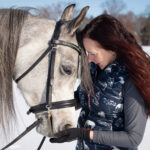Horse Brain, Human Brain is a book that dives into the subject of how horses think, feel, and learn as well as the similarities and differences to how humans think, feel, and learn. This book was a fantastic read and I would include it on my must read list for anyone who works with horses.
Horses have evolved to think, learn, and react a certain way in order to survive as a prey animal. Humans have evolved very differently and therefore behave and learn very differently. But our horses have been taken out of their natural environment and now live in a human world. It would be similar to you being dropped off in a foreign country where you don’t know the language, culture, or where anything is located.
Understanding why horses do things the way that they do as well as how they see the world around them is key to a successful partnership.
As Janet says in the opening chapter:
Working with a horse’s brain- instead of against it- smoothes every mutual interaction, from a pasture greeting to open flight over an eight foot puissance wall. Too often, horse-and-human partnerships are a one-way street on which we command and they respond. To a surprising degree, many horses accept unilateral pronouncements. But training improves by leaps and bound- becoming safer, gentler, faster, more effective, and immeasurably more interesting- when communication within the partnership flows in both directions. We then begin to experience the world through the brain of another species. It’s an amazing felling, and it illuminates everything we can know about true horsemanship.
Horse Brain, Human Brain, page 9
This book is very thorough while still being easy to read and understand. The concepts are well explained without an overuse of technical jargon making this an excellent read for anyone from a brand new rider to a professional who has worked with horses for many years.
The books starts by explaining how horses use their senses to interact with the world around them, often times in different ways than we humans do. It then goes on to describe concepts such as neural fatigue (when neurons stop responding to a constant stimulus), proprioception (knowing where our body is in relation to the world around us), emotions and how and why they occur the way that they do, and different types of reinforcement. Understanding these things better makes us a better partner for our horses and helps us to communicate with them in a way that they can actually understand.
The book then gives insight into how we can best approach working with and teaching our horses so they can best respond to what we are asking them to do. Most “problems” that occur with horses happen because the horse does not understand, is afraid, or is in pain. Horses see the world very differently than we do and in order for us to effectively work with them we need to understand this.
So all that to say, I would highly recommend that you check out this book!
You can find it on Amazon here-


